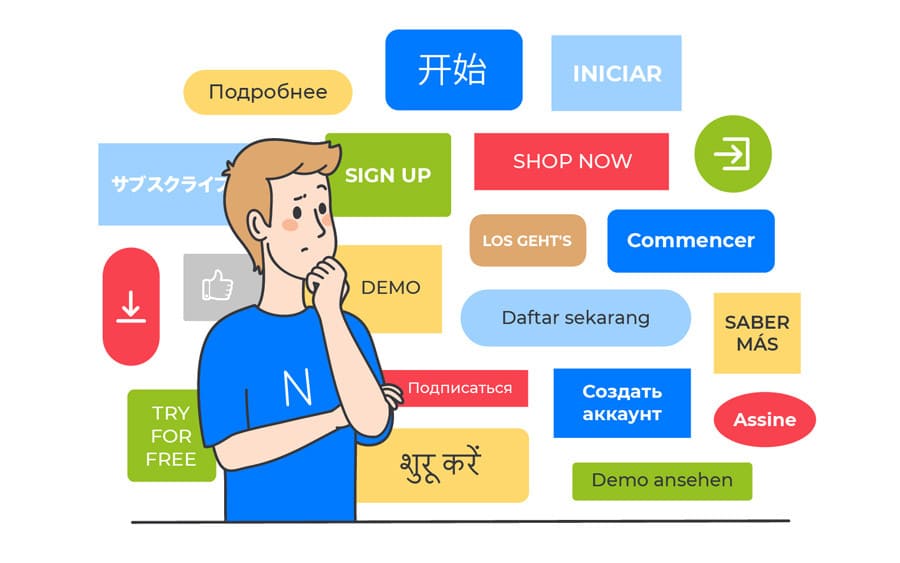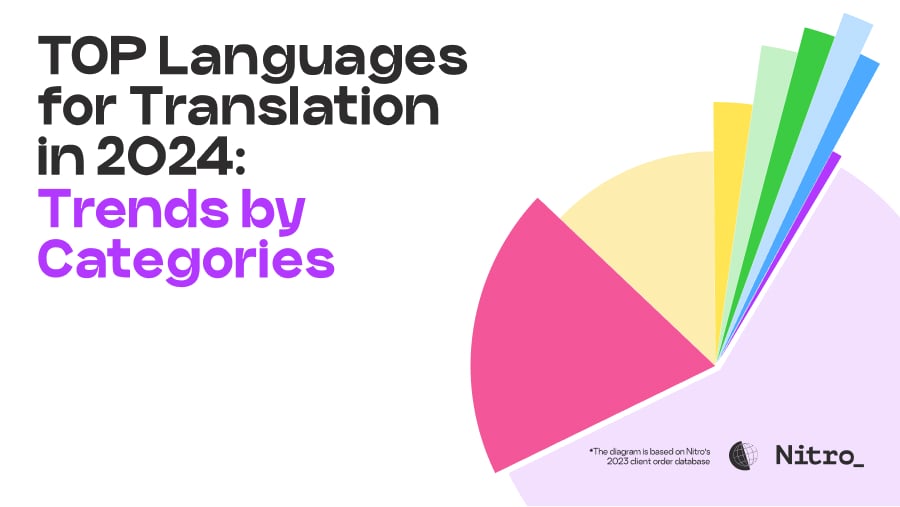Image created by alconost.com
Localization helps your product grow and develop. When a company reaches the point where it needs localization, that's a growth point. Anna Zanevskaya and Stas Kharevich discuss how localization works at Alconost and how the company manages quality control.


Stas and Anna are Alconost's localization department team leads. They work to improve process quality and oversee teams of localization managers.
When is localization required?
Localization may become necessary at various stages of the product life cycle. The product has just come on the market. Or the product is already operational, and people are using it, but you need to expand to more users and add new locales.
Sometimes, companies hire their own translators to localize their product, or delegate translation to employees: sales teams, regional managers, or marketers. But it's important to realize that localization is a distinct type of work, a major process, which demands expertise.
And if you need localization into less common languages — Bengal, Marathi, Burmese, there are hundreds of them — even just finding a translator can be a headache. Not to mention that you'll need another native speaker of that language to check the first person's work, someone who also needs to be found and tested.
In those situations, a company that offers professional localization services can help.
Their typical client is a medium-sized IT company, with a product such as a mobile app. When the company decides to start selling that product in a new market, it brings in investment for further development, and starts looking for localization services.
At Alconost, we've helped more than 2000 companies in tech, marketing, tourism, media, and other areas localize their products into hundreds of languages. We'll tell you how we do it.
Need help with translation or localization? Book a call with our team!
What does our localization team look like?
Stas:
Effective localization means high-quality translation completed on time with minimal additional costs. You need a good team to make that happen. Our localization team consists of:
- professional native-speaker translators, editors and proofreaders,
- localization managers,
- vendor managers.

Image created by alconost.com
What the translators do is probably self-explanatory.
Localization managers are responsible for the localization process and for client communications. We have "two-in-one" experts: they have linguistic experience, and they act as project managers. Experience has taught us that for localization managers, that combination is vital.
Vendor managers select new translators, test them, and train the ones that pass the tests to work on our projects. We consider it a real advantage having these guys on our team, because it helps us select top-class translators.
Currently we have 24 managers working with over 500 translators.

What are the steps in the localization process?
Stas:
The localization process is pretty universal across different companies. There is the ISO 17100 standard that regulates the localization process, and we hold that certification. Following this process, there is the preparatory phase, sort of like pre-production, when all the pertinent information for the project gets systematized. This includes gathering all the inputs, compiling a glossary, and setting up the project in a specialized translation platform. Then there's the translation phase. Here, we pay special attention to context, and ask clarifying questions to the client when necessary. To conclude this phase, we proofread the translation. The third phase is in-country review. This includes receiving feedback from users in the region for which the localization was completed, analyzing that feedback, and, when necessary, refining the existing translation and working out rules or recommendations for the future.
That's what localization looks like to the client. But for us, the process starts a bit differently, with the step of selecting translators.
How we work with translators
Anna:
Vendor managers are responsible for selecting translators. They monitor and collect linguists' resumes from various sources, from LinkedIn to specialized platforms. We require that translators are native speakers of that language, have an education in linguistics, and have verified experience translating in a specific area.
Usually, we ask new translators to list the subject areas in which they're most competent: software, tourism, or marketing, for instance. There should not be too many subject areas here, usually three main ones and a couple extra areas. If a translator is an expert in games, for example, we won't have them translate legal documents.
We have a simple, efficient translator onboarding system: tutorials in Google Forms and Trello boards, which translators go through step by step, and also instructions we send to new translators at different stages of the onboarding process. Experience has taught us that providing information in measured doses helps the translator engage with the process gradually and in a high-quality way.
How translator onboarding works for less common languages
Anna:
Sometimes we need to translate an app or a game into less common languages, or even very rare ones. Rare languages are those for which there isn't constant high demand either from our clients or in the market as a whole, and which relatively few people actually speak. For instance, Burmese, Hindi, Odia, Lao, or Dzongkha.
When a client brings us that kind of request, we can start working on the main languages right away, but we offer to find translators for the rare languages. Almost always, the clients are prepared to wait, and usually our search takes a week or two.
How we check the quality of work by candidates for languages we've never worked with before
For rare languages, it's difficult to do quality control if we've never worked with translators in that language before. In this situation, we collect resumes and talk with three or four translators who meet our requirements. Then they do test assignments, and we begin cross checks, which are reviews by other translators. If two translators disagree, we bring in a third, and look at how they defend their choices.
Want to learn more about localization quality assurance at Alconost? Book a call with our team!
What influences hiring decisions: 3 main criteria
We use a few criteria to judge whether a translator is a good fit for us:
- verified translation experience: resume and recommendations from previous clients
- communication skills: we notice whether the translator responds in a friendly, constructive, and timely manner
- grade given by other translators on a test assignment: the quality index must not be below 98%.
The vendor managers' and localization managers' experience plays an important role here. Later on, as we work with translators, we track feedback from the vendor and localization managers, and also client comments.
Localization models and how they function
Stas:
There are two basic models companies use to provide localization services.
One is what we call the three-step model, or TEP (translation-editing-proofreading). This model requires three suppliers: the first translates, the second edits, and the third proofreads. This model can be complex in terms of the distribution of responsibilities, and requires a team in which no one member is 100% responsible for the result; instead, everyone is collectively responsible.
We follow a different model, in which one translator covers the whole process. He or she dives deep into the context and topic and asks the client questions. The translator finishes the translation, then proofreads it, and performs additional quality checks and handles customer feedback.
We also offer proofreading as a service, which can be ordered as an additional step, or for occasions when you only need proofreading for a finished translation.

Image created by alconost.com
We've settled on his model because we believe it's more efficient for one person to bear full responsibility for the entire process and for the results of his or her work. And, of course, we place some serious demands on that translator (and pay them accordingly).
These are the inner workings that the client doesn't pay for.
We wouldn't say that one model is better than the other. Our model requires a high level of responsibility from the translator and strict quality control, so in practice, it's very effective: our average TQI is above 98% (more about this later). In the three-step model, if very competent experts are selected for every step, then that can be effective, as well.
Practice has shown that it's more expensive for clients to build their own localization departments, inside their companies, than to work with us. We've already fine-tuned all our processes, our team is in place, and it's easier for us to scale our processes for any project and any languages. Again, we have our own vendor management department that works with translators and monitors their quality.

How we automate processes and track translation quality
Anna:
Since we started out as a product development company, we've created our own convenient platform, Alpha, which automates management of localization and quality control processes.
We love working in Alpha, and it's great that we can enhance it for new types of tasks. Right now, inside this ecosystem, we can:
- manage projects
- monitor quality
- work with suppliers.
Everything is automated and transparent for the whole team, and Alpha has integration with Slack. There's also a project tracker, so we see when the translator has accepted a task, and we can track that and keep the client up to date.
The manager can see the translator's whole history: his or her TQI, comments from other managers, past mistakes, their last audit, translator analysis, and preferred subject areas.
Alpha is for our internal processes. Communication with clients, on the other hand — depending on the project and how long it is — might be through the Crowdin platform, Slack, Trello, or Jira. We're flexible and set things up in the way that's most convenient for the client.
Speaking of localization quality, I should mention that we use one of the most efficient models available today: MQM, Multidimensional Quality Management. It's a flexible model that gives us the ability to adjust the most important parameters just the way we need them.
Quality control frequency is set in Alpha. This means that we get notified on a particular schedule that a translator is due to be audited. Sometimes, vendor managers do that more frequently, if needed.
What is TQI, and how is it measured?
TQI, the Translation Quality Index, measures the quality of a translator's work. We track that index constantly for every translator using a quality monitoring system. This is what we do: we take a piece of text from a real project the translator worked on, around 250 or 300 words. We load it into the platform and assign a reviewer, an experienced translator with a high quality index, and the reviewer checks the translation. That is how we calculate the TQI, which grades the quality of the translator's work.
We use the same system to check test assignments from new translators.
We've loaded our requirements regarding errors, meaning how much weight they carry, into the platform. Each company has its own approach to TQI. For us, an acceptable level is 98% or above, which is a fairly high number. We make sure that translation quality never falls below that level.
Want to know how we help set up localization? Book a call with our team!
What to do if translation quality starts to drop
What if the TQI falls? That can happen. Translators are human beings, and sometimes there are force-majeure circumstances. Our localization managers track those instances and propose solutions. Sometimes the translator just needs a break, or a less intense period of work, and sometimes they need more training. We have an internal translator coaching system. It works along the same lines as onboarding, using Google forms and Trello cards. If training is needed in Crowdin or time management skills, we offer all those opportunities.
What do we assess apart from quality?
We track an indicator called NPS. While TQI has to do with each translator specifically, the Net Promoter Score tells us how satisfied the client is with us as a service provider.
After every project, the client gives their relationship with us a satisfaction score, grading communication, quality, and the localization manager's performance.

Image created by alconost.com
3 lifehacks from Alconost for managing big localization projects
Anna:
Big projects need more localization managers
When a project is large and complex, we assign a team of localization managers. They divide up the work among themselves either by language, function, or the individual step each person is responsible for: translation, updates, linguistic testing, and internal quality control.
How to be in touch with a client 24/7
Sometimes localization managers are assigned according to the time of day they're available. Some have an easier time working in the mornings, and some have clients in other time zones. This adds flexibility and helps everyone maintain a healthy work-life balance, and clients are happy that there's always a manager available.
We have up to four managers working on certain projects.
Group calls to synchronize efforts and get to know each other
Every month, or whenever necessary, we hold conference calls with our clients to synchronize plans. That's how we discover their needs, and they learn more about us and our processes. Clients often take a real interest in quality control at Alconost. They want to be certain they're paying for expertise.
If you want to learn more about other aspects of localization, and our company's processes, we'd be delighted to talk with you. We want as many companies as possible to obtain high-quality localization for their products so they can grow and advance.
Do you need help with your localization tasks? Contact us and order localization services










